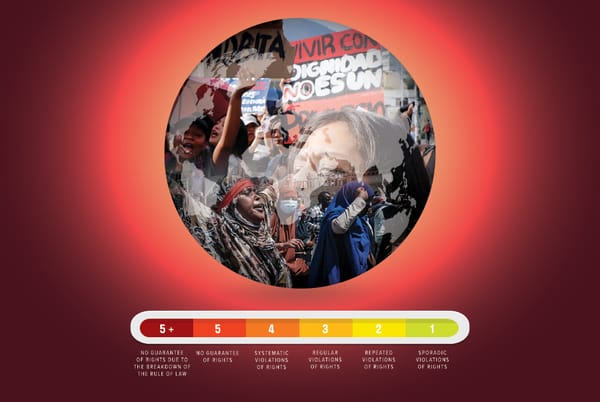
In October, researchers at Statistics Canada released a troubling report on paid sick leave coverage. With the public health implications of the pandemic in mind, researchers compared workers’ access to paid sick leave between 1995 and 2022. The results were telling.
Although access to paid sick days improved modestly over this period, 37.5 per cent of workers still reported that they had no paid sick leave coverage in 2022, according to StatCan. In 1995, roughly 56 per cent of workers reported having paid sick days. In 2022, this figure — captured in the monthly Labour Force Survey — had improved to 64 per cent.
Marginal improvements in coverage, however, are largely the result of limited public policy interventions in Prince Edward Island, Quebec and British Columbia since 1995.
In January 2022, the government of B.C. amended the provincial Employment Standards Act to guarantee workers five annual days of paid sick leave, five fewer than recommended by public health and labour relations experts. Pre-pandemic, both Quebec and P.E.I. had very limited paid sick days policies: two annual days in Quebec, only one in P.E.I. (after five years of continuous employment).
As the StatCan authors summarize, short-term paid sick leave coverage rose between 13 to 15 percentage points in these three jurisdictions. By contrast, coverage improved “at most” by 5 percentage points across the remaining provinces. Even where coverage improved, the number of paid sick days available to many workers dependent on minimum employment standards remained few and inadequate.
Where paid sick leave coverage improved — and where it didn’t — was also instructive. While access to paid sick days rose 6.8 percentage points among men of all ages, it grew by 10.3 percentage points among women. This was likely the result of women’s greater concentration in lower-wage, public-facing jobs, making them more dependent on employment standards laws for their rights at work. Small legislative changes, like those in B.C., probably had a disproportionately positive impact on women. Consequently, in 2022, slightly more women (65.1 per cent) than men (63.4 per cent) reported access to paid sick days.
Workers in precarious forms of employment, such as part-time or temporary jobs, gained greater access to paid sick days between 1995 and 2022, but still had far lower overall coverage than the less-precariously employed.
Men and women in full-time, temporary jobs saw coverage rise by 14 and 16.1 percentage points, respectively. Yet, men and women workers in this employment form were much less likely to have paid sick days than their counterparts in permanent jobs. In 2022, 35.7 per cent of men in full-time, temporary jobs reported having paid sick days, compared with 71.4 per cent of men in permanent, full-time jobs. Among women, just more than half of those in the temporary category had paid sick days, compared to 79 per cent of permanent employees.
Access to paid sick days also continued to vary significantly by wage rate and firm size. The StatCan report breaks paid sick leave coverage down by wage decile. Eighty-seven per cent of those in the top tenth of hourly wage earners reported having paid sick days. By contrast, only 22.6 per cent of workers in the bottom decile reported that they had paid sick days in 2022. The lower your position on the wage distribution, the less likely you were to report having paid sick days.
Paid sick days were also positively correlated with firm size. According to StatCan’s figures, the larger the firm in which you work, the more likely it was that your employer provided paid sick days. More than 72 per cent of workers in firms with 500 or more employees had paid sick days, compared to just under 35 per cent of workers in small firms with between one to 19 employees.
In short, lower-waged workers and workers in small firms continue to be less likely to have paid sick days, which confirms what scholars of precarious employment have long argued: small firm size and low hourly wages are key indicators of risky and precarious work.
Unsurprisingly, having a union in your workplace greatly improved access to paid sick days. More than 77 per cent of unionized men reported paid sick days in 2022, compared to 57.3 per cent of non-unionized men. The impact of collective agreement coverage is even greater for women: 83.4 per cent of unionized women had paid sick days vs. just 56.1 per cent of those without a union at their job.
The federal government tabled its own paid sick leave legislation in November 2021, but it took until Dec. 1, 2022, for federally regulated workers to gain access to 10 paid sick days. Unfortunately, the design of the federal policy in part undermined its efficacy. Workers must “accrue” their entitled paid sick days, one per month, over the course of the year. The StatCan report doesn’t capture the effect of federal paid sick days, though the statistical impact of this policy change would have likely been modest given the small number of federally regulated workers in Canada.
When it comes to short-term paid sick days, Canada remains an outlier. Nearly all OECD countries mandate some form of short-term paid sick leave. Most countries require employers to pay workers’ income replacement during absence due to illness, at least for the initial days of leave.
In some cases, such as in Sweden, Denmark and Iceland, broad access to paid sick days is a result of much higher union density than in Canada. In other words, workers gain access to paid leave because they are covered by a union collective bargaining agreement. However, even in peer countries where union density is not markedly higher than in Canada, paid sick leave coverage is still much better — the result of public policy.
Although Canada provides longer-term paid leaves through a combination of job-protected leaves in provincial employment standards codes and income replacement through provincial workers’ compensations benefits and the federal Employment Insurance program, this patchwork approach is highly insufficient. Wage replacement rates are, on average, much lower than in other peer countries and many workers are excluded for a variety of reasons — for example, because of their employment status or because they have worked too few insured hours. But most importantly, these job-protected leaves of longer duration do nothing to insulate workers from the short-term economic consequences of becoming ill and missing a few days of work.
Lack of legislated paid sick days in most of Canada forces workers, particularly those who work for low wages, to choose between keeping a roof over their head and their health, as well as the health of their coworkers and customers.
In jurisdictions without legislated paid sick days, it is employers who effectively determine whether or not workers can take a paid day off when they’re ill. Placing workers’ health in the hands of their employers not only generates negative public health consequences, it also exacerbates the already highly unequal relationship between workers and employers.
In many respects, short-term paid sick leave is a rare form of ‘common sense’ policy. Paid sick days have been widely shown to provide vital income support, improve public health by limiting the spread of infectious disease and involve very little direct cost to employers. Yet, despite the obvious benefits of paid sick leave policy, employers and right-wing governments remain obstinate in their opposition. Consequently, even after a deadly pandemic that continues to place many frontline service staff in harm’s way, a significant minority of workers lack paid sick days.
To put it bluntly, in most Canadian jurisdictions, governments have learned nothing from the pandemic. Most have chosen to completely ignore workers’ demands for paid sick days. The fight for universal paid sick days continues.
Recent Class Struggle Issues
- November 27 | The Christian Labour Association of Canada Isn’t A ‘Real’ Union
- November 20 | Canada’s Top 0.01% Saw Income Growth Of 30% In 2021
- November 13 | The Federal Ban On Scabs Is A Major Victory For Labour
- November 6 | Striking Seaway Workers Showed The Power Of ‘Essential’ Labour







